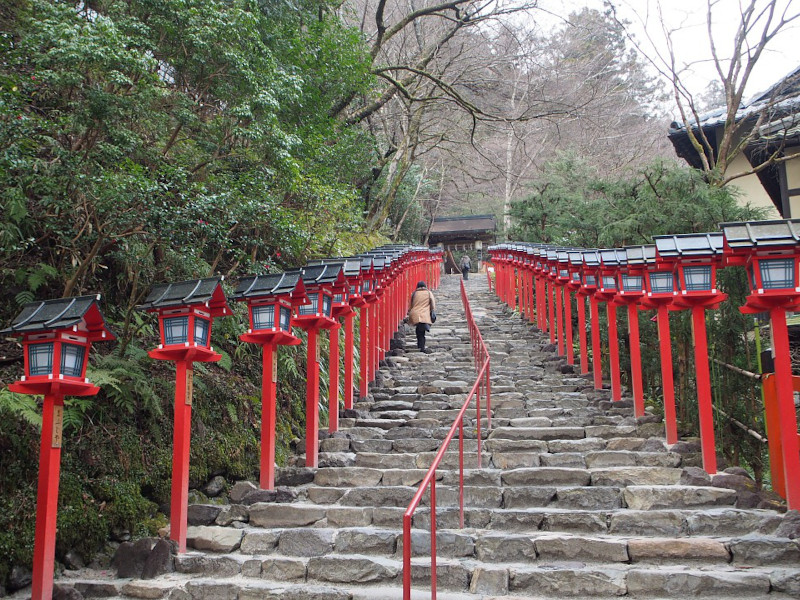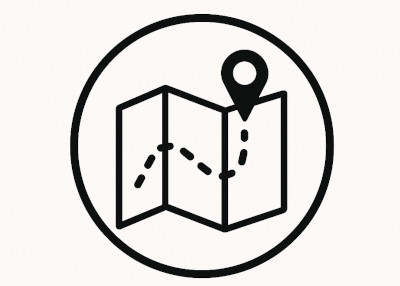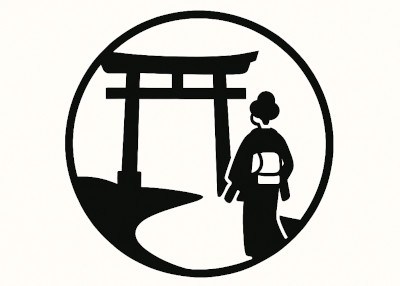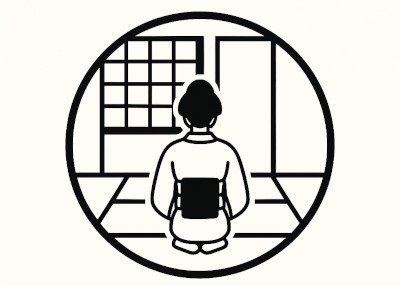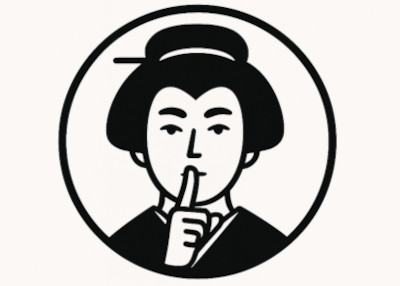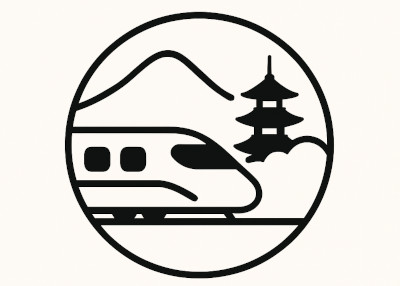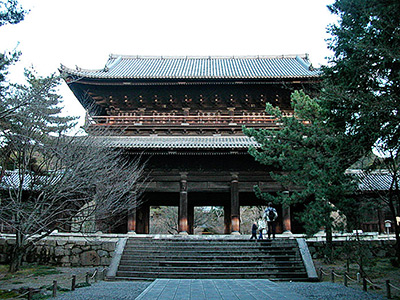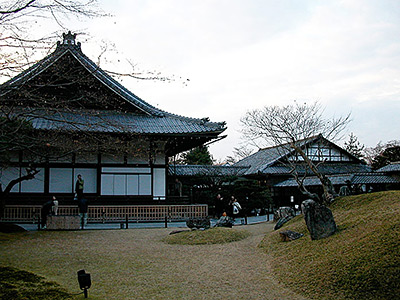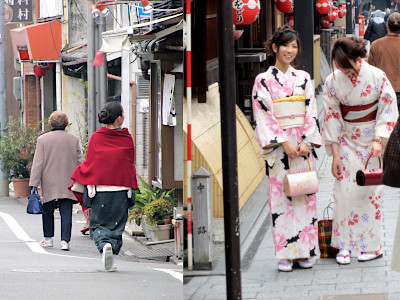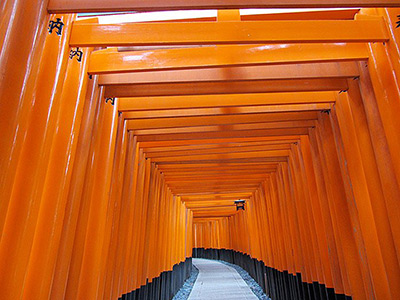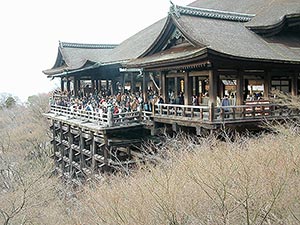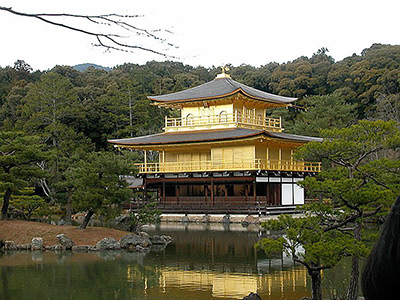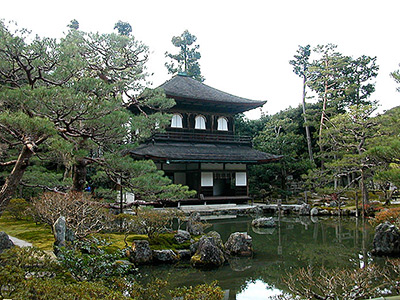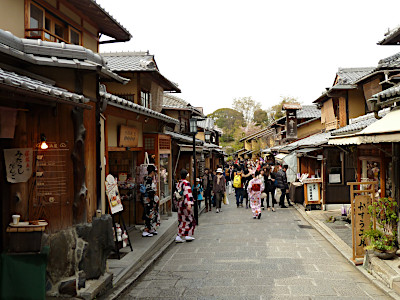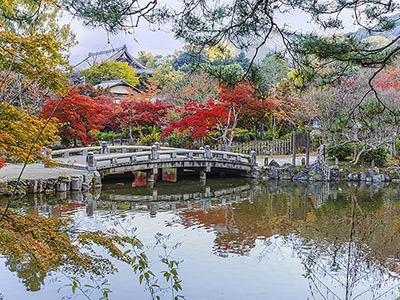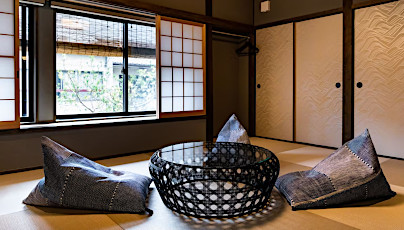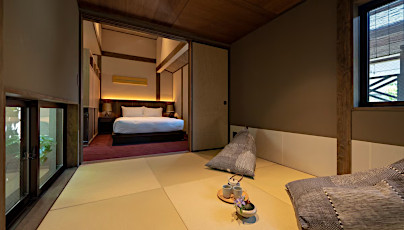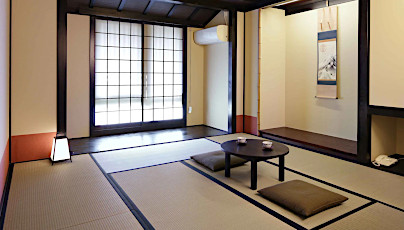Kifune Shrine in Kyoto
This post can contain affiliate links, which means that we may receive a small commission if you make a purchase using these links.
Facts & Figures
The ancient Kifune Shrine complex, also known as Kifune-jinja Shrine, is famous for the beautiful stone staircase lined by red wooden lanterns and maple trees at the entrance. The Shinto shrine complex includes three buildings in different locations in the village of Kibune, which are Hongu (front shrine), Yui-no-yashiro (middle shrine), and Okumiya (rear shrine). These shrines can be found during a 1km hiking tour along the river Kibune.
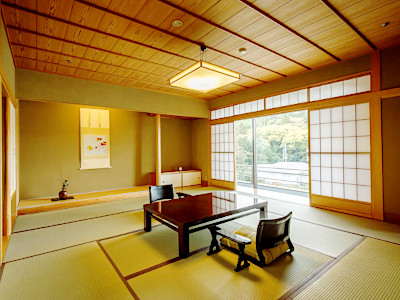 Best Places to Stay in Kyoto >
The shrine is the headquarters of appr. 500 Kifune Shrines located all over Japan. Locals went to this shrine to worship the god of water and rain. Also, people say that the Kifune Shrine brings romance to the people:) My tip: The best time to visit this place is during the cherry blossom season or in autumn when the leaves of the surrounding trees turn into a wonderful red and yellow.
Best Places to Stay in Kyoto >
The shrine is the headquarters of appr. 500 Kifune Shrines located all over Japan. Locals went to this shrine to worship the god of water and rain. Also, people say that the Kifune Shrine brings romance to the people:) My tip: The best time to visit this place is during the cherry blossom season or in autumn when the leaves of the surrounding trees turn into a wonderful red and yellow.
- Kifune Shrine:
- Opening Hours - 6:00 am to 8:00 pm (May to November)
- Opening Hours - 6:00 am to 6:00 pm (December to April)
- Closed - never, open everyday
- Admission Fee - free
History
Kifune Shrine (Kifune-jinja) has a history of over 1600 years. This was long before the founding of Kyoto. The Shinto shrine complex dates back to the 18th Emporer Hanzei (336 - 410). Legend has it that an imperial princess Tamayori-hime (ancestral kami) traveled on a yellow boat from Osaka to Kibune the seek the source of the river. This journey ended in Kibune, where the Kifune Shrine now stands and the two local water gods (Takaokami-no-Kami) became the enshrined gods. Imperial envoys, sake brewers, and farmers came here to pray for rain and a good harvest. Locals would offer during a drought a black horse as a gift to the gods for rain and a white horse to stop the rain. From 1871 until 1946, the Kifune Shrine stood in the second rank of government-supported shrines (Kanpei-chusha).
Location

Kifune Shrine is located in the mountain village of Kibune just 15 km northeast of Kyotos City center.
Address: 180 Kurama-kibune-cho, Sakyo Ward, Kyoto 601-1112
How to get to Kifune Shrine?
- 3min from Kyoto Station to Tofukuji Station by JR Nara Line and
- 12min from Tofukuji Station to Demachi-Yanagi Station by Keihan Main Line and
- 27 min from Demachi-Yanagi Station to Kibune-guchi Station by local train called Eizan Electric Railway and
- 5 minute walk from Kibune-guchi Station to Kifune Shrine
Sightseeing spots
shrine complex:
Hongu - The Main Shrine was rebuilt in 2007. The shrine building has a simple wooden exterior with minimal gold accents that fits well with the surrounding forests. Just in front of Hongu, there is a stone wall that houses a small fountain of holy/sacred water known as goshinsui from Mt. Kibune, where you can try out the refreshing mountain water. Additionally, the main shrine provides a unique way of fortune-telling (mizuura mikuji). Just buy there a fortune-telling sheet (omikuji) and put it in a fountain close to the shrine. As the water finds its way through the paper, it will show your fortune!
Yui-no-yashiro - The shrine is also known as the Nakamiya or inner hall. It is located just 400 meters north of Hongu. The building is much smaller than Hongu. Yui-no-yashiro stands for a place to give love. People tell the story of Ninigi-no-mikoto, the great-grandfather of Emperor Jinmu (first emperor of Japan) couldn't marry the woman he deeply loved. Therefore Ninigi-no-mikoto resided at the temple and blessed people with happy and prosperous relationships. It enshrines the deity Iwanaga-hime-no-mikoto (god of marriage and matchmaking).
Okumiya - This was the location of the original main shrine also known now as rear shrine. A huge flood destroyed the building in 1055. The shrine was reconstructed in a smaller form. The sacred area is known as a spiritual spot for a harmonious marriage. Do not miss the two huge cedar trees (Aioi no Sugi) close to the shrine, which are older than 1000 years. Under the main hall is a water well (ryuketsu) located, which is called the Well where the Dragon God should reside. Another highlight is the boat shaped stone (Funagata-Ishi) near the main hall, which represents the arrival of the Goddess Tamayori-hime-no-mikoto with a boat called Kifune. Now you know where the shrine got its name from. The shrine can be found just 500 meters north of Yui-no-yashiro.
Festival & Events in Kyoto (dates can change without notice)
April
Miyako Odori (1st - 31st)
The traditional annual spring dance of the Kyoto district Gion Kobu performed by Geiko and Maiko is a must-see on your Kyoto visit. Don't miss the most popular dances the Miyako Odori "Cherry Blossom Dances" or "Dances of the Old Capital" at the Gion Kobu Kaburenjo Theater (located close to Gion Corner).
May
Aoi Matsuri (15th)
The highlight of this festival is a large parade from the Imperial Palace through the Shimogamo Shrine and ends at the Kamigamo Shrine (Kamigamo-jinja). More than 500 people wearing aristocratic costumes from the Heian Period (794 - 1185). The Aoi Matsuri belongs with the Gion Matsuri and Jidai Matsuri as the three most famous festivals in Kyoto.
Sangyo-sai festival (lit. "Industry Festival") (8th)
This festival at the Fushimi Inari Shrine has the aim to ensure the prosperity of the nation's industry. On that day dances are performed and offerings are given in large quantities.
June
Kifune Festival - Kifune Matsuri (1st)
The mikoshi (portable shrine) procession along the Kibune river starts at 11.00 am. It is the most important annual festival of Kifune-jinja Shrine. During the procession traditional music will be played. Do not miss the beautiful kagura dance performance at the Kifune Shrine.
July
Gion Matsuri (whole month)
The month of July is full of different events like the Yoiyama - Kyoto's Magical Night (locals in kimonos look at the giant Gion floats the day before the parade) or the famous Yamaboko Junko (float procession on the 17th of July).
October
Jidai Matsuri ("Festival of Ages") (22nd)
People celebrate with a large parade between Imperial Palace to Heian Shrine the anniversary of the foundation of Kyoto. App. 2000 participants wearing historical costumes from different time periods. Enjoy this great festival which lasts around 2 hours.
Where to stay in Kyoto?
Book your Flight Tickets and Rental Car for your Japan trip
Day trips from Kyoto:
Travelers who viewed Kifune Shrine viewed also:
Top rated - Best Machiya Houses in Kyoto
THE MACHIYA Ebisuya, 192 Ebisuya-cho Shimogyo-ku, Kyoto 600-8062
This 3-star guesthouse got an excellent rating. All 30 individually furnished rooms offer free WiFi, air conditioning, bathrooms incl. toilets, fridges, 40-inch flat-screen TVs, and more. THE MACHIYA Ebisuya is located in central Kyoto.
View on Expedia.com
This 3-star guesthouse got an excellent rating. All 30 individually furnished rooms offer free WiFi, air conditioning, bathrooms incl. toilets, fridges, 40-inch flat-screen TVs, and more. THE MACHIYA Ebisuya is located in central Kyoto.
View on Expedia.com
The Machiya Kazahaya, 570-6 Kazahayacho, Shimogyo-ku, Kyoto, Kyoto, 600-8475
The Machiya Kazahaya offers for all guest rooms free WiFi, air conditioning, safes, bathrooms with toilets, refrigerators, and much more. Enjoy also the beautiful Japanese Garden. Guests gave this property the rating - Exceptional.
View on Expedia.com
The Machiya Kazahaya offers for all guest rooms free WiFi, air conditioning, safes, bathrooms with toilets, refrigerators, and much more. Enjoy also the beautiful Japanese Garden. Guests gave this property the rating - Exceptional.
View on Expedia.com
Kyomachiya Ryokan Sakura Urushitei, 425 Kichimonjicho, Shimogyo-ku, Kyoto, 600-8069
This beautiful 3-star guesthouse offers 32 rooms with free WiFi, air conditioning, bathrooms incl. showers and toilets, refrigerators, and much more. Enjoy also the relaxing indoor public bath (no minerals). Guests gave this property the rating - Wonderful.
View on Expedia.com
This beautiful 3-star guesthouse offers 32 rooms with free WiFi, air conditioning, bathrooms incl. showers and toilets, refrigerators, and much more. Enjoy also the relaxing indoor public bath (no minerals). Guests gave this property the rating - Wonderful.
View on Expedia.com

